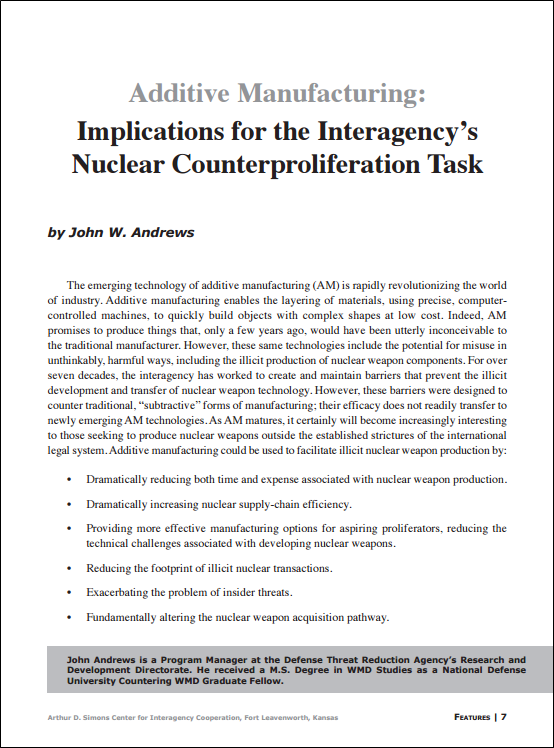Featured Article: Additive Manufacturing: Implications for the Interagency…
Featured article:
Additive Manufacturing: Implications for the Interagency’s Nuclear Counterproliferation Tasks
by John W. Andrews
The emerging technology of additive manufacturing (AM) is rapidly revolutionizing the world of industry. Additive manufacturing enables the layering of materials, using precise, computer-controlled machines, to quickly build objects with complex shapes at low cost. Indeed, AM promises to produce things that, only a few years ago, would have been utterly inconceivable to the traditional manufacturer. However, these same technologies include the potential for misuse in unthinkably, harmful ways, including the illicit production of nuclear weapon components. For over seven decades, the interagency has worked to create and maintain barriers that prevent the illicit development and transfer of nuclear weapon technology. However, these barriers were designed to counter traditional, “subtractive” forms of manufacturing; their efficacy does not readily transfer to newly emerging AM technologies. As AM matures, it certainly will become increasingly interesting to those seeking to produce nuclear weapons outside the established structures of the international legal system. Additive manufacturing could be used to facilitate illicit nuclear weapon production by:
- Dramatically reducing both time and expense associated with nuclear weapon production.
Dramatically increasing nuclear supply-chain efficiency. - Providing more effective manufacturing options for aspiring proliferators, reducing the technical challenges associated with developing nuclear weapons.
- Reducing the footprint of illicit nuclear transactions.
- Exacerbating the problem of insider threats.
- Fundamentally altering the nuclear weapon acquisition pathway…
Read the full article
Additive Manufacturing: Implications for the Interagency’s Nuclear Counterproliferation Tasks PDF
Download the complete edition
IAJ 8-2 (2017) PDF
IAJ 8-2 (2017) ePub
John Andrews is a Program Manager at the Defense Threat Reduction Agency’s Research and Development Directorate. He received a M.S. Degree in WMD Studies as a National Defense University Countering WMD Graduate Fellow.

Posted: May 23, 2017 by Simons Center
READ THE LATEST UPDATES FROM THE SIMONS CENTER
"*" indicates required fields


